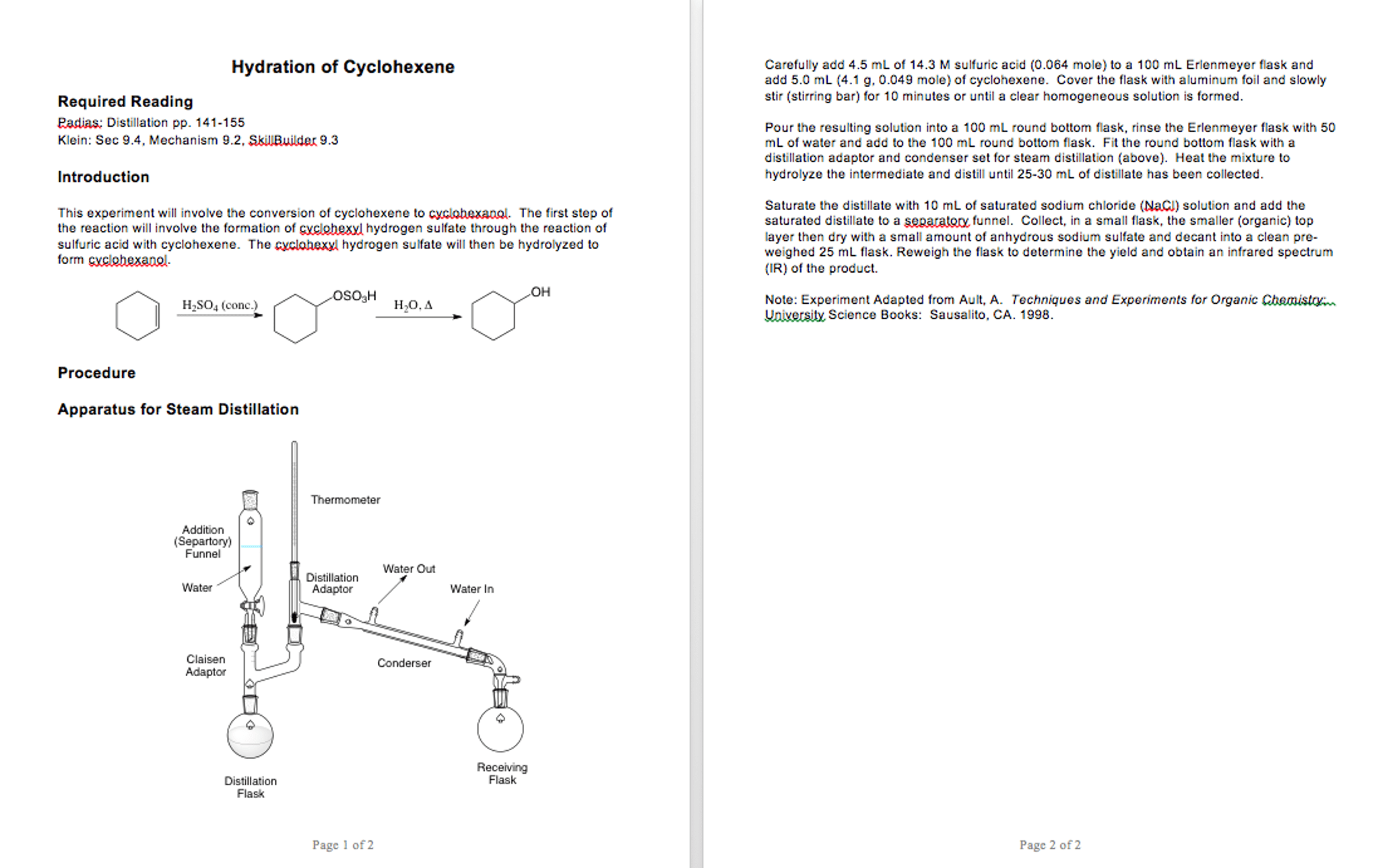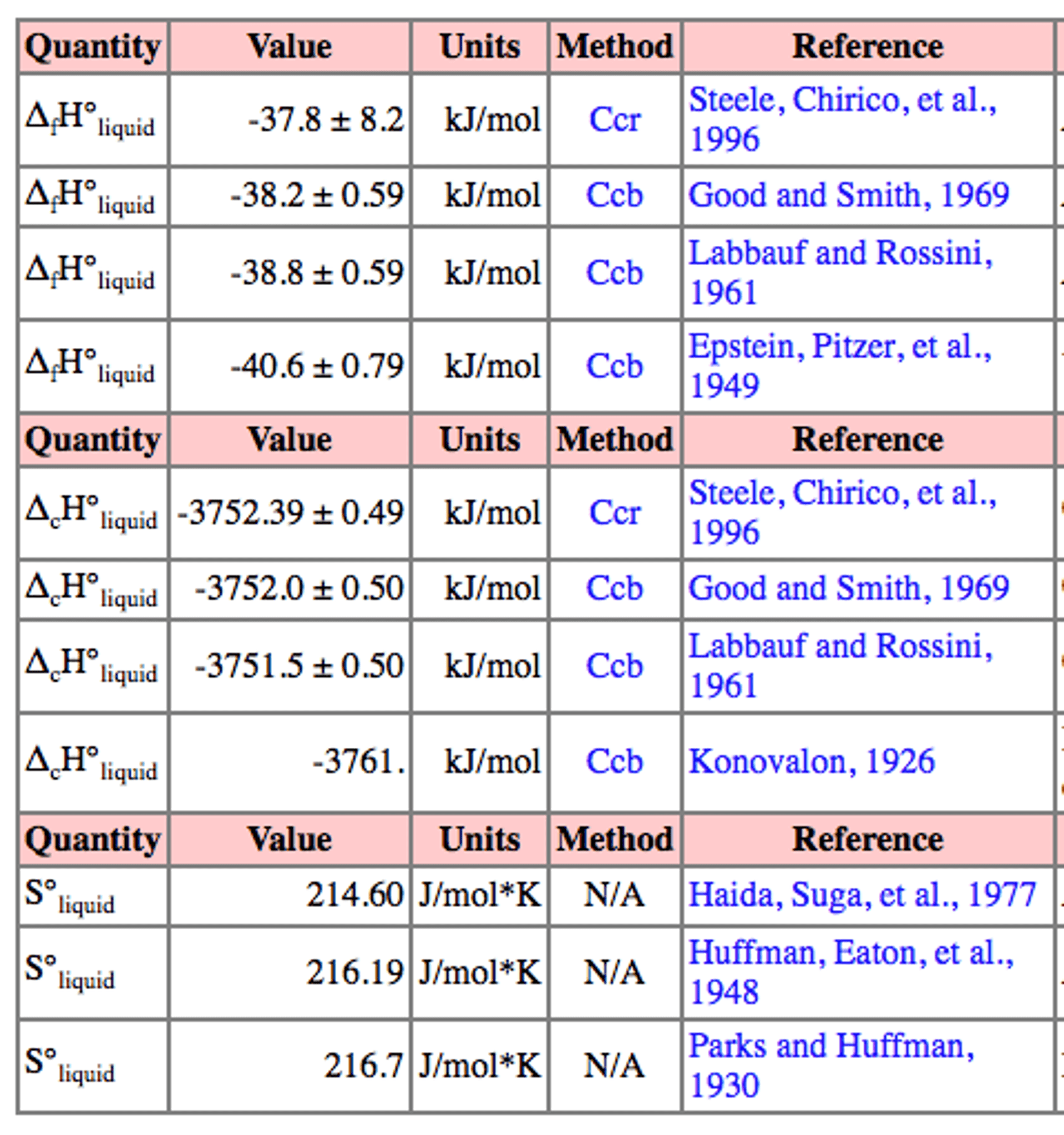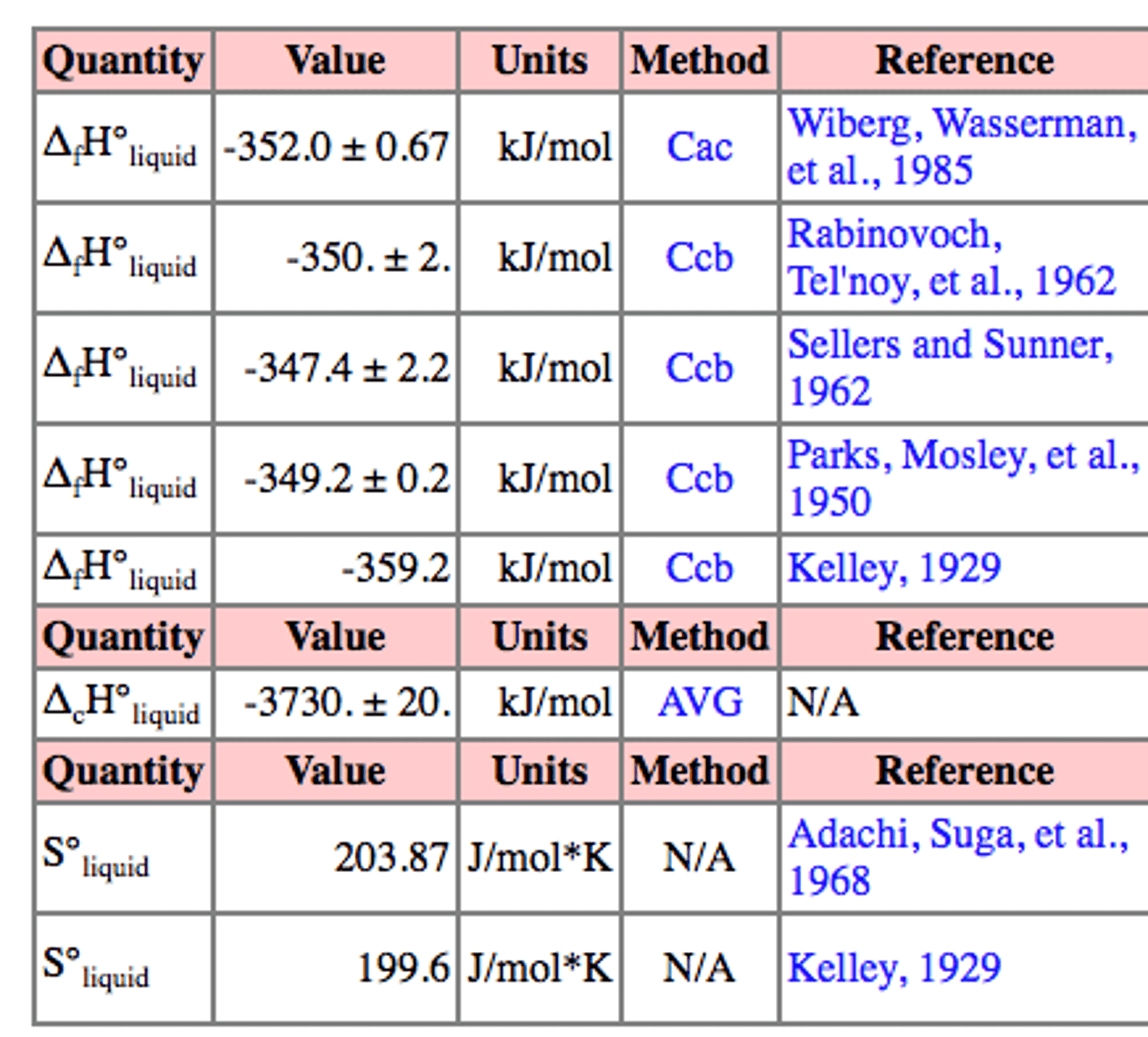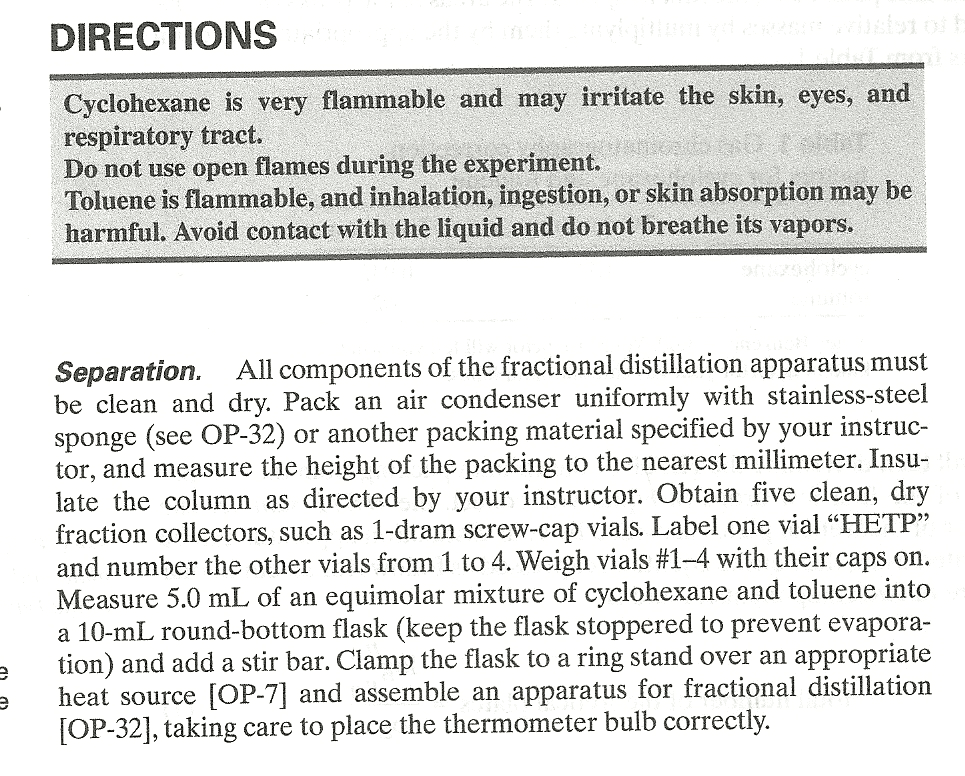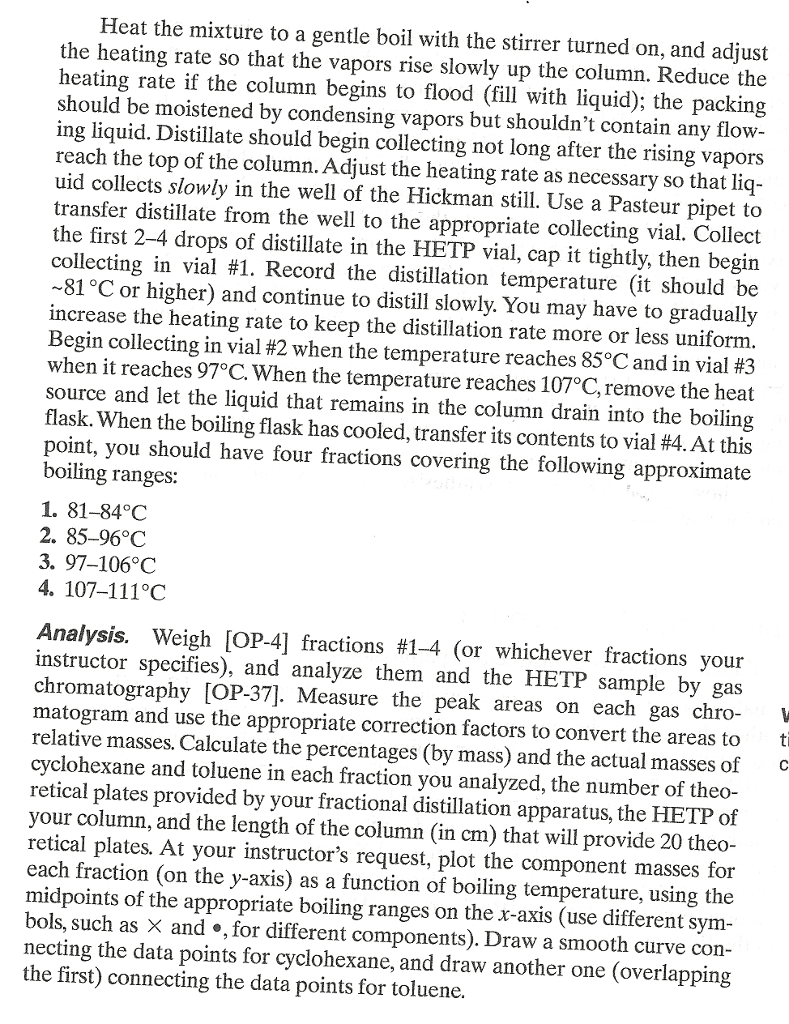For the lab below, what is the separation scheme?
Elimination of 1-octanol.
Apparatus Assembly:
Set up a distillation apparatus.
Using a preweighed 50-mL round-bottom flask as the distilling flask, add 7.5 mL of 1-octanol and weigh it again to determine the exact amount added. Add 2.0 mL of 85% phosphoric acid and 30 drops of concentrated sulfuric acid. Add a magnetic stir bar.
Use a 25 mL round-bottom flask as the receiving flask. Be prepared to immerse it into an ice bath to ensure that no octene vapors will escape into the lab; however, do not add the ice until after the distillation is underway or you will have extra water in your product (from condensation). Even more effectively, you can ice your condenser circulator, but don't do that until after distillation commences either.
Dehydration:
Ensure that the water is flowing in your condenser and begin to heat the distilling flask on the appropriate insert of your heater/stirrer.
The heating should be regulated because ideal time of the distillation should be 30 minutes. Too fast of a distillation will cause an incomplete reaction and isolation of the starting material. The temperature registered by your thermometer will rise very slowly at first, but when the refluxing (soon to be distilling) vapors hit the thermometer, the temperature will rise quickly. It should stabilize as the first condensate begins to form in the distillation condenser; from that point to the end of the distillation, record the range of temperatures: this is your boiling-point range (although in this experiment, the broad distribution of products may cause a broad range of temperatures).
Ideally, you do not want to collect distillate until the temperature is at least 110°C (as the distillate, below this temperature, is mostly water); however, since you will have to remove water anyway, this is not critical. However, you don't want to collect product at temperatures much above the boiling point of the octenes since that will increase contamination of your product with unreacted 1-octanol and SN1 ether byproduct.
Continue the distillation until no more liquid is collected or until tar begins to form; if tar begins to form, stop the distillation. Be sure to not distill the reactants completely, as you will be left with a thick residual tar that will be nearly impossible to remove from the flask.
Isolation and Drying of the Product:
Transfer the distillate to a separate container (flask or separatory funnel) with the aid of an approx. equal quantity of saturated sodium chloride solution (brine). Allow the layers to separate; remove the bottom aqueous layer (using a Pasteur pipet if you chose a flask) and discard it.
Transfer the organic layer (using a dry Pasteur pipet if you chose a flask) in the container to a small round-bottom flask and add a small amount of anhydrous sodium sulfate. Stopper the flask and allow it to sit for 10-15 minutes.
When the product is dry, transfer it to a pre-weighed screw-cap vial (preferably with a Teflon liner) and obtain its mass. Then filter a solution of dichloromethane and product into a GC vial, properly label it, and submit it to the GC vial collection box. The proper ratio of product in dichloromethane is 1 drop in 1-1.2 mL DCM: one drop in a full syringe of DCM.
For this experiment, you will also be required to set up the GC-MS to run your sample by adding your run to the instrument sequence. Follow the instructor's instructions with regard to this task.
For the lab below, what is the separation scheme?
Elimination of 1-octanol.
Apparatus Assembly:
Set up a distillation apparatus.
Using a preweighed 50-mL round-bottom flask as the distilling flask, add 7.5 mL of 1-octanol and weigh it again to determine the exact amount added. Add 2.0 mL of 85% phosphoric acid and 30 drops of concentrated sulfuric acid. Add a magnetic stir bar.
Use a 25 mL round-bottom flask as the receiving flask. Be prepared to immerse it into an ice bath to ensure that no octene vapors will escape into the lab; however, do not add the ice until after the distillation is underway or you will have extra water in your product (from condensation). Even more effectively, you can ice your condenser circulator, but don't do that until after distillation commences either.
Dehydration:
Ensure that the water is flowing in your condenser and begin to heat the distilling flask on the appropriate insert of your heater/stirrer.
The heating should be regulated because ideal time of the distillation should be 30 minutes. Too fast of a distillation will cause an incomplete reaction and isolation of the starting material. The temperature registered by your thermometer will rise very slowly at first, but when the refluxing (soon to be distilling) vapors hit the thermometer, the temperature will rise quickly. It should stabilize as the first condensate begins to form in the distillation condenser; from that point to the end of the distillation, record the range of temperatures: this is your boiling-point range (although in this experiment, the broad distribution of products may cause a broad range of temperatures).
Ideally, you do not want to collect distillate until the temperature is at least 110°C (as the distillate, below this temperature, is mostly water); however, since you will have to remove water anyway, this is not critical. However, you don't want to collect product at temperatures much above the boiling point of the octenes since that will increase contamination of your product with unreacted 1-octanol and SN1 ether byproduct.
Continue the distillation until no more liquid is collected or until tar begins to form; if tar begins to form, stop the distillation. Be sure to not distill the reactants completely, as you will be left with a thick residual tar that will be nearly impossible to remove from the flask.
Isolation and Drying of the Product:
Transfer the distillate to a separate container (flask or separatory funnel) with the aid of an approx. equal quantity of saturated sodium chloride solution (brine). Allow the layers to separate; remove the bottom aqueous layer (using a Pasteur pipet if you chose a flask) and discard it.
Transfer the organic layer (using a dry Pasteur pipet if you chose a flask) in the container to a small round-bottom flask and add a small amount of anhydrous sodium sulfate. Stopper the flask and allow it to sit for 10-15 minutes.
When the product is dry, transfer it to a pre-weighed screw-cap vial (preferably with a Teflon liner) and obtain its mass. Then filter a solution of dichloromethane and product into a GC vial, properly label it, and submit it to the GC vial collection box. The proper ratio of product in dichloromethane is 1 drop in 1-1.2 mL DCM: one drop in a full syringe of DCM.
For this experiment, you will also be required to set up the GC-MS to run your sample by adding your run to the instrument sequence. Follow the instructor's instructions with regard to this task.

